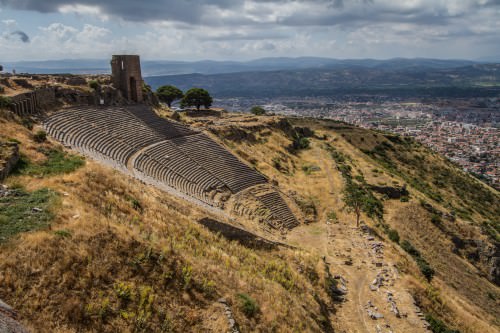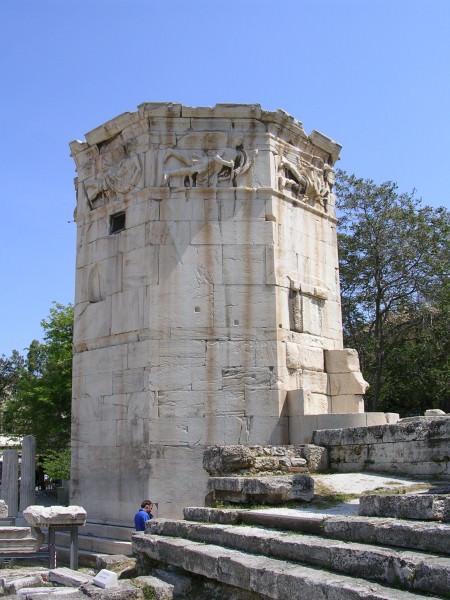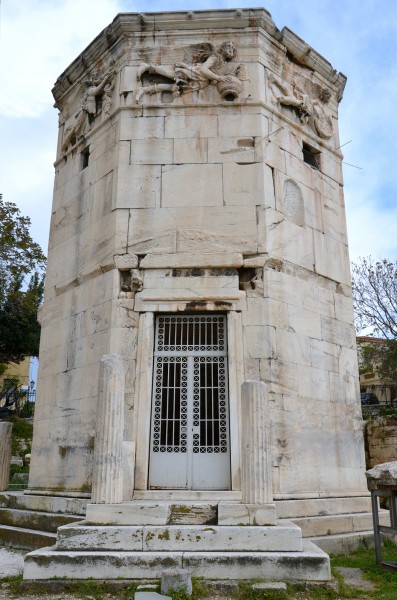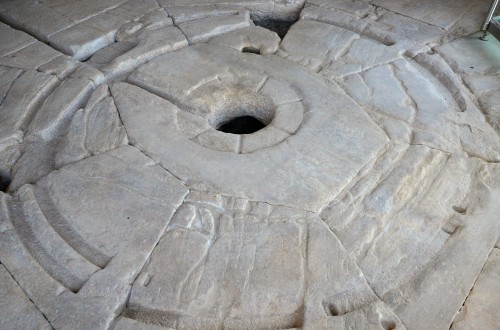Atlas › Attalid Dynasty › Tower of the Winds » Origins and History
Articles and Definitions › Contents
- Atlas › Who Was
- Attalid Dynasty › Origins
- Tower of the Winds › Origins
Ancient civilizations › Historical places, and their characters
Atlas › Who Was
Definition and Origins

In Greek mythology, the Titan Atlas was responsible for bearing the weight of the heavens on his shoulders, a burden given to him as punishment by Zeus. Father of many stars and a protagonist in one of Hercules ' famous labours, Atlas was also known as a wise man and the founder of astronomy. For Plato, he was the eponymous first king of Atlantis, and this giant of a god also gave his name to a huge mountain range in northern Africa, the great Atlantic Ocean and any large collection of s.
With a name perhaps conveying the meaning 'suffering' or 'very enduring,' Atlas was the son of the Titans Iapetus and Clymene (or Themis) and the elder brother of Epimetheus, Menoetius, and Prometheus. Atlas was the father of the nymphCalypso and the seven Pleiades. In a Theban version of events, Atlas is also the grandfather of Niobe.
ATLAS' PUNISHMENT FROM ZEUS
Atlas was given the task of holding up the heavens as punishment from Zeus for leading the Titans in their battle with the Olympian Gods for control of the heavens. In a similar vein, Homer describes Atlas in his Odyssey as 'deadly-minded,' as knowing the depths of all the seas, and as holding the pillars far out in the Atlantic Ocean which hold the heavens and earth apart. Hesiod in his Theogony also describes Atlas as holding up the heavens and locates him in the land of the Hesperides (female deities famed for their singing), which was far to the west, at the edge of the world. Later tradition, including Herodotus, associates the god with the Atlas Mountains in North Africa. It was here that, in punishment for his gross lack of hospitality, the Titan was transformed from a shepherd into a huge rock mountain by Perseus using the head of the Gorgon Medusa with her deadly stare. This story may go back to the 5th century BCE.
THE TITAN ATLAS HELD UP THE HEAVENS, A PUNISHMENT FROM ZEUS FOR WARRING WITH THE OLYMPIAN GODS.
ATLAS & HERCULES
Other associations with Atlas are as the father of many constellations, as a source of great wisdom and founder of astronomy, and, by Plato in his Critias, as the original king of Atlantis. Perhaps the most famous myth involving Atlas, though, is his role in one of the celebrated twelve labours of Hercules. The hero was required by Eurystheus to fetch the golden apples from the fabled gardens of the Hesperides, which were sacred to Hera and guarded by the fearsome hundred-headed dragon Ladon.Following the advice of Prometheus, Hercules asked Atlas (in some versions the father of the Hesperides) to get him the apples while he, with the help of Athena, took the world onto his shoulders for a while, giving the Titan a welcome respite.Perhaps understandably, when returning with the golden apples, Atlas was reluctant to reassume the burden of carrying the world. However, the wily Hercules tricked the god into swapping places temporarily while the hero got himself some cushions to more easily bear the tremendous weight. Of course, as soon as Atlas was back holding the heavens, Hercules with his golden booty, hot-footed back to Mycenae.

The Farnese Atlas
REPRESENTATIONS IN ART
In Greek art, Atlas is, from the 6th century BCE, often featured in depictions of the labours of Hercules, most notably in a metope from the temple of Zeus at Olympia (c. 460 BCE) where he stands in the gardens of the Hesperides. Similar scenes were also popular on Greek pottery decoration, particularly with his brother Prometheus. In Hellenistic and Roman times, Atlas is frequently represented in his now familiar position with bent knees and back, straining to hold the globe on his shoulders. Perhaps the most outstanding example of this pose is the 2nd-century CE sculpture now in the Archaeological Museum of Naples.
Attalid Dynasty › Origins
Definition and Origins

The Attalid dynasty ruled an empire from their capital at Pergamon during the 3rd and 2nd century BCE. Fighting for their place in the turbulent world following the death of Alexander the Great, the Attalids briefly flourished with Pergamon becoming a great Hellenistic city famed for its culture, library, and Great Altar. However, the Attalid's short-lived dynasty came to an abrupt end when mighty Rome began to flex its muscles and show greater ambition in Asia Minor and beyond.
With the death of Alexander the Great in 323 BCE, the empire he created was left without leadership - no heir and no successor. Out of a number of possible options, the immediate solution reached by his loyal commanders was to divide the kingdom among themselves. The young general and bodyguard Lysimachus received the strategically valuable province of Thrace - a small kingdom located along the Hellespont. The Wars of the Diadochi brought him into a power struggle for lands in both Asia Minor and Macedon. His thirst for power enabled him to build alliances with a number of his fellow “kings” and even marry the daughter of Ptolemy I of Egypt, Arsinoe. Unfortunately, his death at the Battle of Corupendium in 261 BCE left him without an heir and his throne vacant. His rich territories in Asia Minor, most importantly Pergamon, fell to the Syrian king Seleucus I. However, a new dynasty would soon emerge and eventually wrestle control away from the Seleucids - Pergamon would shortly become an important power along the Aegean Sea under the guidance of the Attalids.
PHILETAERUS: FOUNDER OF THE EMPIRE
Little is known of the early life of Philetaerus. Possibly of Macedonian origin, he was the son of Attalus and Boa, a native of Paphlagonia. While there is some disagreement among historians, his adopted son, Eumenes I, always considered Philetaerus to be the true founder of the Attalid dynasty. Originally, he served under the Macedonian commander Antigonus the One-eyed until in 302 BCE when he deserted Antigonus amid the growing tension among the various kings and joined the Thracian sovereign Lysimachus. After the death of Antigonus in 301 BCE at the Battle of Ipsus, he was rewarded for his loyalty by being appointed to oversee the king's treasury situated in the Asia Minor city of Pergamon. Regrettably, when Lysimachus, at the urging of his Egyptian wife Arsinoe, executed his only son Agathocles on the trumped-up charge of treason, Philetaerus, along with several other loyal commanders, abandoned Lysimachus and joined Seleucus I - Philetaerus made sure to hand-over the treasury and Pergamum to the Seleucids. After the death of Lysimachus at the hands of the Seleucid forces, Philetaerus assumed control of Pergamon. He would govern there, although still under the umbrella of Seleucus I, from 282 to 263 BCE.
DURING HIS TWO DECADES ON THE THRONE, PHILETAERUS WAS ABLE TO BOTH EXPAND HIS TERRITORY INTO THE CAICUS VALLEY AS WELL AS DEFEND IT AGAINST THE NEIGHBORING GALATIANS.
During his two decades on the throne, Philetaerus was able to both expand his territory into the Caicus valley as well as defend it (278 – 276 BCE) against the neighboring Galatians, a people to the east of Pergamum. Instead of waging war his successors would occasionally pay to keep them away. Although there is no substantial proof, history depicts him as a eunuch.While there is little evidence as to how this condition arose, his family may have chosen that path because it often enabled a person to obtain a high position at court. Under his guidance, and that of his successors, the city and territory of Pergamon would become a Hellenistic showcase.
Despite being located in Asia Minor, Pergamon was, by definition, a Greek city identifying with its neighbor Athens across the sea with the city even adopting the goddess Athena as its presiding deity. She was its protector in time of battle, earning the name “Nikephoros” or “victory bearer.” While the Attalids may have adopted the civil organization of Athens, the king would continue to stand “outside the constitution,” maintaining the power to appoint the city's magistrates. Since Philetaerus was unable to have children, his adopted nephew, Eumenes I, succeeded him in 263 BCE, serving until 241 BCE. It was Eumenes who proposed a break from the control of Seleucids. After defeating the successor to the Seleucid dynasty, Antiochus I, at Sardis, Eumenes expanded his territory into northwestern Asia Minor by absorbing Mysia and Aelis as well as Pitane.

Theatre of Pergamon
ATTALUS: FOUNDER OF THE DYNASTY
Having no children of his own, Eumenes I was succeeded by his nephew and cousin Attalus I (241 – 197 BCE) who would assume the title of Soter or Savior. It would be Attalus who would be credited by most historians with founding the kingship of the Attalids - although he personally gave credit to Philetaerus. Since the defeat of Lysimachus, the Seleucids had never been able to maintain control over their Asia Minor territories, and it was for this reason, that the territories of Pergamon, Bithynia, Nicomedia, and Cappadocia emerged into independence. Like his predecessor, Attalus was able to expand his small empire, although he would later relinquish much of this conquered territory to Seleucus II (223 -212 BCE). Like his predecessor, he was also able to protect Pergamon against the menacing forces of the bordering Galatians.
It was Attalus I who was instrumental in establishing positive relations with the Roman Republic and for involving them in the First Macedonian War. He was also influential, along with the island of Rhodes, with bringing Rome back to Greece to wage war against Philip V of Macedon - at the time Rome was recovering from the Second Punic War with Carthage. In the Second Macedonian War (200 – 197 BCE) Philip V had set his sights on expanding his power into Greece and the Aegean, threatening the Achaeans, Pergamon, and Athens. After a bitter fight, he eventually was forced to make peace and relinquish all conquered lands In Greece, Thrace and Asia Minor. Unfortunately, before the peace agreement could be signed, Attalus I died at Thebes from a stroke in 197 BCE and his body was returned to Pergamon. Eumenes II (197 to 159 BCE) the eldest son of Attalus and Apollones assumed power and immediately continued his father's war only this time against the son of an old enemy, Antiochus III of Syria.
RELATIONS WITH ROME
The heir to the Seleucid's dynasty longed to reclaim his family's lost territory in Asia Minor. After an appeal from the Attalids, Rome urged Antiochus to withdraw to Syria; however, instead, he attacked Rome's ally, Greece. After suffering a defeat at Thermopylae, he fled to Asia Minor where he was engaged and defeated at the Battle of Magnesia in Lydia (189 BCE). In the battle Eumenes's forces drove Antiochus to retreat, causing his elephants to run wild. Antiochus had incorrectly assumed his scythed chariots would cause panic among the Romans, but Eumenes, instead, wisely sent his cavalry, Cretan archers, and light-armed slingers against the charging horses. The Syrian forces fell susceptible to the Roman legions under the leadership of Cornelius Scipio Africanus. The resulting Peace of Apamea crippled the Seleucid Empire by forcing Antiochus III to pay reparations to Eumenes (he would become extremely wealthy) and withdraw from Asia Minor - the territory north of the Taurus would be split between Pergamum and Rhodes. Rome would later intervene in Eumenes's wars against Bithynia (187 to 183 BCE) and Pontius (183 to 179 BCE).

Empires of the Mediterranean, 218 BCE.
Oddly, an old enemy of Rome from the Second Punic War reappeared in the war with Bithynia. The old Punic commander Hannibal Barca had initially sought refuge with Antiochus III after his exile from Carthage but quickly fled to Bithynia. Although he would win a naval victory over Eumenes, the subsequent peace agreement called for the release of Hannibal to the Romans. Refusing to surrender, the old commander reportedly committed suicide by taking poison in 182 BCE.
PERGAMON FLOURISHES
Afterwards, Eumenes II (also calling himself Soter) went on a building program in Pergamon, erecting the Great Altar and establishing a massive library, second only to Alexandria. In the War of the Brothers he helped Antiochus IV succeed to the throne of Syria after the death of his brother Seleucus IV (175 BCE). Unfortunately, however, his efforts to bring Rome into another Macedonian war caused him to fall into disfavor with the Romans, especially the Roman Senate. Supposedly, he was to keep Rome informed of the actions of Perseus, the successor of Philip V of Macedon. When Eumenes II travelled to Rome (167 to 166 BCE), the Senate would not receive him, claiming they no longer received kings. Apparently, his enemies in Rome maintained he had planned to abandon Rome in favor of Perseus if the right price was right. To Rome the king had already demonstrated far too much independence and power - especially after he provided aid to Antiochus IV and made war with Bithynia. Apparently, Rome did not appreciate any attempt to diminish their influence in Asia Minor.

Reconstruction of the Pergamon Altar
ATTALUS II & III
Attalus II Philadelphus ('brother–loving') was the second son of Attalus I and at the urging of Rome, he became co-ruler with his brother, serving from 160 to 138 BCE. He had functioned as both a commander under Eumenes II against Antiochus III as well as the war opposing the Galatians. He had also served as a diplomat to Rome where he fell into favor with the Romans.After his brother's death in 159 BCE, Attalus assumed sole control of the throne, marrying his brother's widow Stratonice and adopting his nephew, the future Attalus III. During his reign, he would maintain close ties with Rome, recognizing their supremacy. His armies supported Nicomedes II of Bithynia, Alexander Balas in Syria, but opposed Andriscus in Macedon.While continuing his brother's building program at home, he founded the cities of Philadelphia in Lydia and Attaleia in Pamphylia. Unfortunately, his adopted son, Attalus III (138 to 133 BCE), would be the last Attalid king. Considered by many to be brutal and unpopular, he was disinterested in public life and relinquished control of Pergamon to Rome. Although there was another claimant - a supposed illegitimate son of Eumenes II named Eumenes III Aristonius - the dynasty came to an abrupt end.
Unlike the dynasties of the Ptolemys and the Seleucids, the Attalid dynasty lasted barely a century and a half with much of that under the leadership of a father and his two sons. The family had gained power over Pergamon after the death of Lysimachus, eventually freeing themselves from the rule of the Seleucids. Although Pergamon lay in Asia Minor, the city and province were, by any definition Greek, identifying with the city of Athens, even adopting Athena as their deity and protector. However, a series of long wars against Macedon and Syria brought the expanding Roman Republic onto the scene. After defeating Carthage in the Punic Wars, the Republic had set its sights eastward to Greece and Asia. In the end, Pergamon, under the poor leadership of Attalus III, surrendered without incident to Rome. The short-lived dynasty was no more.
Tower of the Winds › Origins
Ancient Civilizations
The Tower of the Winds, also known as the Clock of Andronicus Cyrrhestes, is a timekeeping tower on the eastern side of the Roman agora of Athens. Built in the 2nd century BCE, it once had nine sundials and contained a large water clock. Recently cleaned and restored, visitors can now finally enter the tower as part of the visit to the agora.

The Clock of Andronicus Cyrrhestes
The Tower of the Winds in Athens, as indicated by an inscription on one sundial, was built by the astronomer Andronikos (Andronicus), son of Hermias, and from Kyrrhos (Cyrrhus) in ancient Macedon, and so it became known as the Horologion of Kyrrhestos. The precise date of the tower's construction is not recorded and, although some scholars suggest on astronomical grounds it was built in the early 1st century BCE, the majority of historians give greater weight to the architectural style which suggests construction in the 2nd century BCE.
The tower is an octagonal structure which stands 13.5 metres high on a base of three steps, all built using Pentelic marble.There are two doorways, both with short porches, one on the northeast side and the other on the northwest side. On the south side of the building is a cylindrical annexe. The ribbed marble roof is conical and once had a bronze weathervane which indicated the direction of the wind. The historian R. Hannah points out that the form of the roof, when seen by approaching from the acropolis, resembles Mt. Lycabettus, a large hill now surrounded by the urban sprawl of Athens.

Tower of the Winds (Athens)
Personifications of the winds are carved in relief at the top of the tower on all eight sides, hence the popular name for the structure as the Tower of the Winds. The tower's vane took the form of Triton, the mythical fish-tailed monster, holding a rod in his right hand which would point down at the sculpture of whichever wind was blowing at the time. The representations of the winds gods all bear their names and each carries a particular symbol to help identify them. Below are the gods, their direction, and a short description of their appearance on the tower reliefs:
- Boreas – North - A bearded male wearing a tunic and cloak. He holds a shell trumpet.
- Kaikias – Northeast – A bearded male in a tunic and cloak. He holds a shield full of hailstones.
- Apeliotes – East – A young male whose cloak is filled with fruit and grain.
- Euros – Southeast – A bearded male whose cloak billows in the wind.
- Notos – South – A young male in a tunic and cloak. He is emptying an amphora of water.
- Lips – Southwest – A young male in a cloak. He is holding the stern of a ship.
- Zephyros – West – A young male whose cloak is filled with flowers.
- Skiron – Northwest - A bearded male in a tunic and cloak. He has an overturned metal vase which has spilt hot coals.

The interior of the Tower of the Winds (Athens)
The tower was much more than a glorified weather vane, though, for it also contained a large water clock which ran on water from the acropolis spring and it had no fewer than nine sundials on its outer walls, both spherical and plain types. The clock was referenced in the works of Vitruvius ( On Architecture 1.6.4-7) and Varo ( On Farming 3.5.17) but has, unfortunately, been lost. All that remains today are channel holes in the flooring which conducted water from a reservoir adjoining the south wall. Vitruvius was impressed with the tower and based its design on his sketch of the perfect city with octagonal walls facing each of the winds.
The location of the tower is not coincidental as merchants at the nearby agora would have been able to better estimate when their goods might be arriving by sea. The Tower was converted into a church or baptistry during the early Christian period and became a Dervish place of worship or tekke in the mid-18th century CE. Restoration work was completed in 2016 CE and now, after many years closed, visitors can once again enter the tower.
LICENSE
Article based on information obtained from these sources:with permission from the Website Ancient History Encyclopedia
Content is available under License Creative Commons: Attribution-NonCommercial-ShareAlike 3.0 Unported. CC-BY-NC-SA License